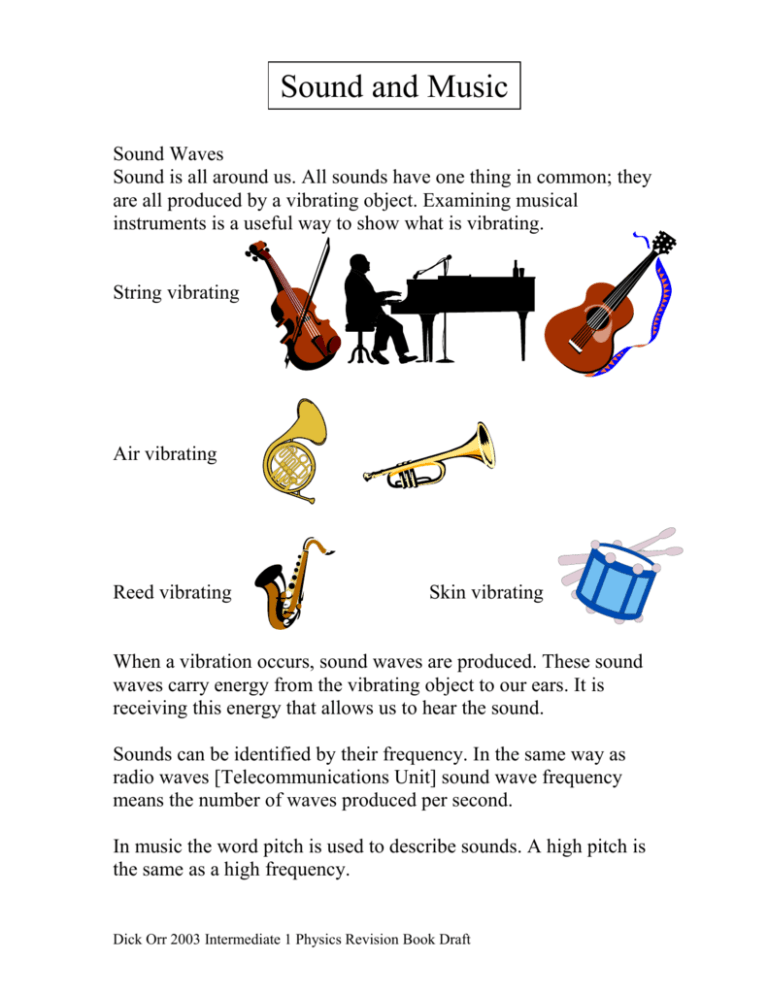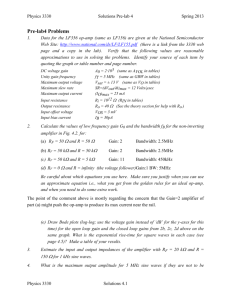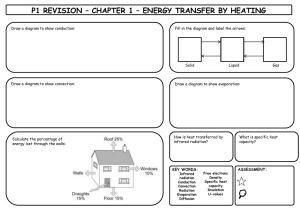One octave higher: frequency = 256 x 2 = 512 Hz
advertisement

Sound and Music Sound Waves Sound is all around us. All sounds have one thing in common; they are all produced by a vibrating object. Examining musical instruments is a useful way to show what is vibrating. String vibrating Air vibrating Reed vibrating Skin vibrating When a vibration occurs, sound waves are produced. These sound waves carry energy from the vibrating object to our ears. It is receiving this energy that allows us to hear the sound. Sounds can be identified by their frequency. In the same way as radio waves [Telecommunications Unit] sound wave frequency means the number of waves produced per second. In music the word pitch is used to describe sounds. A high pitch is the same as a high frequency. Dick Orr 2003 Intermediate 1 Physics Revision Book Draft The apparatus shown speaker can be used to oscilloscope examine the electrical signal that produces sound from a signal loudspeaker. generator The shape of the pattern produced by the oscilloscope depends on the frequency of the sound and also on its loudness. This is the pattern produced when a sound is played through the loudspeaker. This is the pattern produced when a louder sound of the same frequency is played through the loudspeaker. The number of waves in the pattern has not changed. The height of the waves has increased. This is the pattern produced when a sound of the same loudness but increased frequency is played through the loudspeaker. The number of waves in the pattern has increased The height of the waves has stayed the same. Dick Orr 2003 Intermediate 1 Physics Revision Book Draft Louder sounds always have waves that go higher up the oscilloscope screen. Higher frequency sounds always have more waves on the oscilloscope screen. There is a special way of describing a frequency that doubles or halves. Frequencies are said to be one octave apart if their frequency changes by a factor of two. It is called an octave because eight white keys separate these frequency changes on a piano keyboard. 128 Hz 256 Hz 512 Hz Original frequency 256 Hz One octave higher: frequency = 256 x 2 = 512 Hz One octave lower: frequency = 256 ÷ 2 = 128 Hz The frequency of a vibrating string can be increased in two ways. One way is to increase the tightness of the string. Performers often do this when they are tuning their instruments. Another way is to shorten the length of the string. Performers do this when they play stringed instruments, moving their fingers along the fretboard. Dick Orr 2003 Intermediate 1 Physics Revision Book Draft Musical instruments that use air as their vibrating material produce higher notes by decreasing the length of the air column. The trombone is a good example of this. Trombone B will produce a higher note than trombone A because the vibrating air column is shorter. A B Speed of Sound Sound travels through air in the form of waves. These waves take time to travel from one place to another. Sound travels quickly through air but light travels even faster. An example of this is when there is a thunderstorm. Lightning and thunder are produced at exactly the same time in the cloud. You will always see the flash of lightning before you hear the rumble of thunder. [If you get both at the same time you’ve just been struck by lightning!!!] Dick Orr 2003 Intermediate 1 Physics Revision Book Draft We can measure the speed of sound in air by doing an experiment. In the experiment we have to measure the distance that the sound travels. That is distance ‘d’ in the diagram below. We also have to measure how long it takes for the sound to travel that distance. The electronic timer measures the time for the sound to go from one microphone to the other. screwdriver bottle timer microphone d microphone When we have both of these measurements, the speed can be calculated using the equation distance speed = time Example: distance = 1.5 m time = 0.0044 s speed = distance time = 1.5 = 341 m/s 0.0044 Any method used to measure speed of sound must measure both a distance and a time. Dick Orr 2003 Intermediate 1 Physics Revision Book Draft Using Sound Sound can travel through solids, liquids and gases. Sound will travel along the string in a string telephone. Dolphins communicate by passing sound through water. We can hear people singing because the sound travels through the air. Sound cannot travel through a vacuum. Dick Orr 2003 Intermediate 1 Physics Revision Book Draft Range of Hearing Humans are not able to hear every sound that is produced. If a sound is produced outside the frequency range 20 – 20 000 Hz then we will not hear it. Other animals are able to hear sounds outside this range. up to 45 000 Hz up to 30 000 Hz up to 80 000 Hz If a sound has a higher frequency than humans can hear [above 20 000 Hz] it is called Ultrasound. Cats, dogs and whales can all hear some ultrasound. Ultrasound is used in medicine to examine unborn children. Ultrasound is used in industry to help metals plate better. Dick Orr 2003 Intermediate 1 Physics Revision Book Draft It is important that sound level values are kept to a reasonable level. If the sound level is too high then it is possible that hearing could be damaged. Sound levels are measured in the unit called the decibel (dB). Some common sounds with their decibel levels are shown below. 0 dB The softest sound a person can hear with normal hearing 10 dB normal breathing 20 dB whispering at 5 feet 30 dB soft whisper 60 dB normal conversation 80 dB ringing telephone 110 dB shouting in ear 120 dB thunder 150 dB jet engine taking off If sound levels are above 85 dB then damage will occur if no protection is used. Ear defenders should be used in situations where the sound level is above 85 dB. If there is a source of loud noise that causes a disturbance it is known as noise pollution. Some examples of this could be airport noise, roadworks, heavy traffic, and noisy neighbours. Dick Orr 2003 Intermediate 1 Physics Revision Book Draft Amplified Sound An amplifier can be used to make a sound louder. An amplifier is used as part of the school tannoy system; it allows the headteacher to speak to everybody in the school without having to shout. The amplifier only makes the sound louder; it does not change its frequency. We know this because we can recognise the voice that comes through the tannoy. Amplifiers are also used in music performances, public address systems [in airports or railway stations] The system is made up of three parts: 1. Microphone: changes sound energy into electrical energy 2. Amplifier: gives the electrical signal more energy 3. Loudspeaker: changes the electrical signal back into sound. A measure of how much louder a sound can be made is by finding out the voltage gain of the amplifier. This is how many times bigger the voltage is made. To calculate this value we need to know the voltage going into the amplifier, called the input voltage. We also need to know the voltage coming out of the amplifier, called the output voltage. voltage gain = output voltage input volt age Dick Orr 2003 Intermediate 1 Physics Revision Book Draft Example: A cassette player amplifier has an input voltage of 0.02 volts. The voltage from the amplifier to the loudspeaker is 3.0 volts. Calculate the voltage gain. voltage gain = 3.0 output voltage = = 150 0.02 input volt age Your voice If you hear a recording of your voice it sounds different to how you normally hear your voice when you speak. The reason for this is that normally the energy from your voice travels through your skull to your ears and the recorded sound energy is travelling through air. This is why singers wear earphones when recording songs so that they can hear how they actually sound. CD versus Cassette CDs have become more popular than cassettes as a way of listening to music. There are various reasons for this 1. The quality of sound reproduction from a CD is better. 2. CDs do not wear away each time you play them. 3. CDs cannot be damaged by magnets. Dick Orr 2003 Intermediate 1 Physics Revision Book Draft • Sound waves All sounds are produced by vibrations Sounds travel as waves and carry energy from one point to another The frequency of a sound is the number of waves produced every second. Frequencies are measured in the unit the hertz (Hz) High frequency sounds can also be described as being high pitched On oscilloscope screens a wave with a larger amplitude(height) has a louder sound On oscilloscope screens the pattern with a larger number of waves has a higher frequency A difference of an octave between sounds means that the frequency of one sound is double the other For a vibrating string 1. Tighter string higher frequency 2. Shorter string higher frequency The longer a vibrating air column the lower the frequency • Speed of sound Sound waves travel slower in air than light waves To measure the speed of sound you need to 1. measure the distance the sound travels(d) 2. measure the time it takes the sound to travel that distance(t) The speed of sound can be calculated using speed = distance time Dick Orr 2003 Intermediate 1 Physics Revision Book Draft • Using sound Sound is able to pass through solids, liquids and gases Sound cannot pass through a vacuum Humans can normally hear sounds in the frequency range 20 20 000 Hz Sounds that are above the highest frequency that humans can hear are called ultrasounds Ultrasound is used in medicine for 1. Scanning unborn babies in the mother’s womb 2. Speeding up healing of soft tissue injuries Ultrasound is used outside medicine for 1. Welding plastics 2. Cleaning objects in waterbaths Excessive sound levels can be a problem, this is called sound pollution 1. Heavy traffic 2. Loud neighbours Excessive sound levels can damage hearing. • Amplified sound Amplifiers make the energy of a signal larger but do not change its frequency A speech amplification system [the tannoy] needs three parts 1. microphone to change sound into electrical energy 2. amplifier to increase energy of electrical signal 3. loudspeaker to change electrical back into sound energy The number of times bigger the amplifier makes the input voltage is called the voltage gain of the amplifier Voltage gain = output voltage input volt age Dick Orr 2003 Intermediate 1 Physics Revision Book Draft Your own voice sounds different to you because the vibrations carry through the bones in your skull instead of through the air. Compact discs are less prone to interference than cassette tapes and can store more information Questions 1.(a) For the instruments above say what vibrates to produce sound. (i)Horn (ii)Violin (iii)Drum (b) The horn produces a sound with a pitch of 280 Hz. (i) There is another word that can be used instead of pitch. What is it? (ii) What does 280 Hz tell you about the vibration of the air in the horn? 2. A piano key when pressed produces a sound of frequency 300 Hz. A key one octave higher is now pressed. What is the frequency of this new note? 3. Trumpet B Trumpet A Which of the two trumpets shown above will produce the highest note? Explain your answer. Dick Orr 2003 Intermediate 1 Physics Revision Book Draft 4. . Two sounds are passed into a microphone. The trace produced on an oscilloscope from each sound is shown below. Trace P Trace Q (a) Which trace represents the quieter sound? (b) Which trace represents the higher pitched sound? 5. Two students want to measure the speed of sound. One student sets off a firework at one end of the playing field. The second student is at the other end of the playing field. The second student sees the explosion then later hears the sound. (a)Why is there a delay between seeing the explosion and hearing the sound? (b)What measuring instruments would the students need to do this experiment? (c)The length of the field is 200 metres. The sound takes 0.58 seconds to travel this distance. Calculate the speed of sound. Dick Orr 2003 Intermediate 1 Physics Revision Book Draft 6 . A student uses a sound meter to measure a range of sounds. When they drew up their table they were very careless. They mixed up the sound levels and the noises. They also forgot to put headings into the table. normal conversation a quiet room heavy traffic jet plane 120 60 30 90 (a)Redraw the table putting in headings, units where needed and match up the values to the correct noises. (b) Why is it important that we are not exposed to excessive noise? (c) Give two examples of noise pollution. 7.(a) What is the highest frequency normally heard by humans? (b) What do we call frequencies of sound above this value? (c) Give one medical and one non-medical use for these frequencies of sound. 8. A student is investigating the working of an amplifier. They measure the input voltage and the output voltage. The measurements are given below Input voltage = 0.5 volts Output voltage = 4.5 volts (a)Calculate the voltage gain of the amplifier. (b) The frequency of the output signal from the amplifier is 400 hertz. What is the frequency of the input signal? 9. Explain why your voice sounds different to you when you hear it played back from a tape. Dick Orr 2003 Intermediate 1 Physics Revision Book Draft 10. Give two advantages of listening to or recording music on a CD instead of a cassette tape. Dick Orr 2003 Intermediate 1 Physics Revision Book Draft








